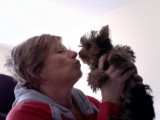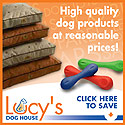No one will argue that you love your dog. You took great care in researching his food and the vet you use. You buy him cute dog toys and see that he gets a great walk every day. But do you take care to keep your dog safe in the car? No one would think of putting their child into the car without buckling up their seat belt or childseat… and you should take the same care with your other “children”, your dogs. Keep your pet safe.
Not only are dogs a major distraction to driving, it is dangerous for the dog to be loose in your automobile or to be hanging out of the window. A dog in a crash can become a major projectile delivering harm to passengers, driver and themselves. Although there is not adequate research, it is estimated that 30,000 accidents are caused annually by unrestrained pets who distract the driver. A pet that weighs 60 pounds in a 35 mph crash will have an impact force of 2700 pounds. That can do some damage!
Legislation is coming to enforce drivers to buckle safety belts for their dogs while riding in a car. Hawaii already has in place a law that prohibits dogs from riding in the driver’s lap. Troy, Michigan has a city ordinance which requires the dog to be restrained in the car at all times. Oregon currently has legislation under consideration. California prohibits untied dogs from riding in the back of pickups. Do we really need legislation to care for our dogs? I think not! So be a responsible pet owner. There are lots of pet safety products and dog safety gear available. It’s for your safety and your dogs!
An easy, familiar dog restraint is a harness designed for the car. It is the perfect choice for securing car safety for your dog. Unlike the one you use on your daily walks, a harness designed for use in the car will not break during the crash. It is simple to buckle and unbuckle from your existing seat belt system, making it easy to get your dog in and out of the car. They are also designed to remove stress from the neck area and transfer the impact of the crash to the dogs chest. They are adjustable, comfortable and allow the dog some room to move, lie down or sit up. The safest place to buckle your dog into the car is the middle of the back seat. This position will prevent him from hanging out the window but he can still catch the scent on the breeze. You do not want your dog hanging out the window, even if they love it, because even the smallest speck can seriously damage your dog’s eyes or nose. If he must hang out, purchase some doggles (dog goggles) to protect his eyes. You especially do not want to put your dog in the front seat if you have air bags. Air bags launch with such force that they could kill your dog with the impact.
You can also buy a car seat for your dog. Car seats for pets give a secure and comfortable place to ride and can even elevate your pet, making it easier to see out the window. Crates are another option. If you crate your dog in the car, secure the crate. Also make sure the crate has a crash rating. Splintering crates can become deadly missiles in the event of a crash as well!
Another reason to restrain your dog while traveling is to protect the dog if you are disabled in a crash. A loose dog may run away from the first responders to your accident. They could be injured and unable to receive immediate care. First responders may never even know your dog was in the car. Having some information about your dog and a photo somewhere in your car can help keep your dog safe and insure he gets responsible care.
You know you love your dog and it’s great to travel with your dog. It is fun to have them along on errands or for a ride to the park. It is the responsible pet owner who ensures the safety of his dog by buckling them into the car where they are secure and you know what they are doing!
View the original article here
Filed under: Uncategorized | Tagged: Automobile, Safety | Leave a comment »















